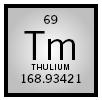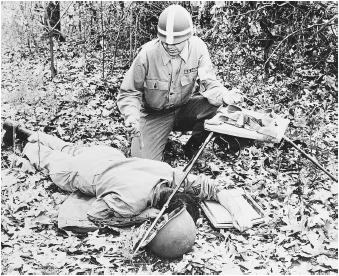Thulium

MELTING POINT:
1,545°C
BOILING POINT:
1,950°C
DENSITY:
9.32 g/cm
3
MOST COMMON ION:
Tm
2+
, Tm
3+
Thulium is a silver-grey metal with a bright luster. Swedish chemist Per Theodor Cleve discovered the metal in 1879 while processing the ore erbia. One of the materials Cleve extracted from the ore was a green substance he named "thulia"—a thulium oxide. The element's name is derived from an ancient name for northern Europe, Thule.
Thulium is the least abundant of the naturally occurring rare earth elements, although it is believed to have a natural abundance similar to gold,

silver, and cadmium. Its abundance in the earth's crust is approximately 0.52 milligrams per kilogram. Thulium is commercially extracted from monazite (which is composed of up to 0.007 percent thulium) using ion exchange and solvent extraction techniques. It is also found in the minerals gadolinite, euxenite, and xenotime.
The most common isotope of thulium is 169 Tm, which has a natural abundance of 100 percent and is the only stable isotope. Other isotopes range from 145 Tm to 179 Tm and have half-lives ranging from 0.36 milliseconds ( 147 Tm) to 1.92 years ( 171 Tm). Examples of thulium compounds include thulium iodide (TmI 3 ), thulium fluoride (TmF 3 ), and thulium oxide (Tm 2 O 3 ).
Thulium metal is soft, ductile, and malleable and can be cut with a knife. It tarnishes when in contact with air and reacts with water. Thulium has very few commercial uses. Radioactive thulium can be utilized as a power source for portable x-ray machines and is produced by irradiating the element in a nuclear reactor. Thulium may also be utilized to make magnetic ceramic materials found in microwave equipment.
SEE ALSO Cleve, Per Theodore .
Stephanie Dionne Sherk
Bibliography
Lide, David R., ed. (2003). In The CRC Handbook of Chemistry and Physics , 84th edition. Boca Raton, FL: CRC Press.
Internet Resources
Gagnon, Steve. "It's Elemental: Thulium." Jefferson Lab. Available from http://education.jlab.org/itselemental/ele069.html .